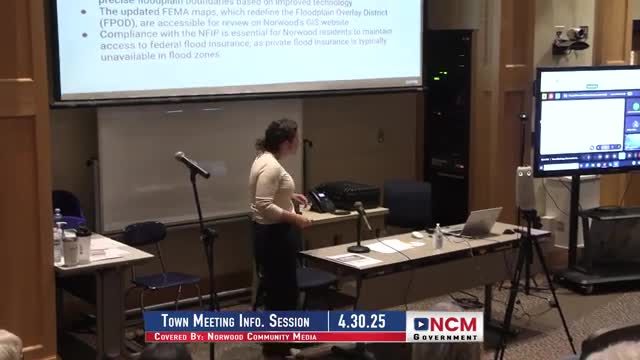Norwood updates floodplain management rules to comply with National Flood Insurance Program changes
May 01, 2025 | Town of Norwood, Norfolk County, Massachusetts
This article was created by AI summarizing key points discussed. AI makes mistakes, so for full details and context, please refer to the video of the full meeting. Please report any errors so we can fix them. Report an error »

During a recent information session held on April 30, 2025, the Town of Norwood discussed critical updates to its floodplain management regulations, which are essential for residents seeking access to federal flood insurance. The proposed changes, outlined in Article 7, aim to align local zoning bylaws with the latest requirements from the National Flood Insurance Program (NFIP).
The NFIP mandates that towns adopt updated regulations within six months of federal program changes, and Norwood is on track to meet this deadline. The updated Federal Emergency Management Agency (FEMA) maps, which redefine the floodplain overlay district, are currently available for public review, although some residents have reported difficulties accessing them through the town's GIS website. Town officials encouraged residents to reach out for assistance if they encounter issues.
A significant concern raised during the meeting was the potential impact of these changes on residents who may find themselves newly classified within floodplain areas due to the updated maps. If adopted, the new regulations could affect property owners' eligibility for flood insurance, as those newly included in floodplain zones would need to secure federal insurance rather than private options.
Officials acknowledged the importance of notifying residents about these changes, particularly for those who may not have easy access to online resources. There was a consensus that proactive communication is necessary to ensure that all affected residents are informed about how the new floodplain designations could impact their insurance requirements and property values.
In addition to the floodplain updates, the meeting touched on the upcoming changes to Massachusetts state building codes, which will also take effect on July 1, 2025. These changes are expected to enhance compliance with floodplain construction regulations, further ensuring the safety and preparedness of the community.
As the town moves forward, officials are committed to keeping residents informed and engaged in the process, recognizing that these regulatory updates are not just technical adjustments but vital components of community safety and resilience. The next steps will involve finalizing the adoption of the updated regulations and exploring ways to effectively communicate these changes to all residents, particularly those who may be most affected.
The NFIP mandates that towns adopt updated regulations within six months of federal program changes, and Norwood is on track to meet this deadline. The updated Federal Emergency Management Agency (FEMA) maps, which redefine the floodplain overlay district, are currently available for public review, although some residents have reported difficulties accessing them through the town's GIS website. Town officials encouraged residents to reach out for assistance if they encounter issues.
A significant concern raised during the meeting was the potential impact of these changes on residents who may find themselves newly classified within floodplain areas due to the updated maps. If adopted, the new regulations could affect property owners' eligibility for flood insurance, as those newly included in floodplain zones would need to secure federal insurance rather than private options.
Officials acknowledged the importance of notifying residents about these changes, particularly for those who may not have easy access to online resources. There was a consensus that proactive communication is necessary to ensure that all affected residents are informed about how the new floodplain designations could impact their insurance requirements and property values.
In addition to the floodplain updates, the meeting touched on the upcoming changes to Massachusetts state building codes, which will also take effect on July 1, 2025. These changes are expected to enhance compliance with floodplain construction regulations, further ensuring the safety and preparedness of the community.
As the town moves forward, officials are committed to keeping residents informed and engaged in the process, recognizing that these regulatory updates are not just technical adjustments but vital components of community safety and resilience. The next steps will involve finalizing the adoption of the updated regulations and exploring ways to effectively communicate these changes to all residents, particularly those who may be most affected.
View full meeting
This article is based on a recent meeting—watch the full video and explore the complete transcript for deeper insights into the discussion.
View full meeting
